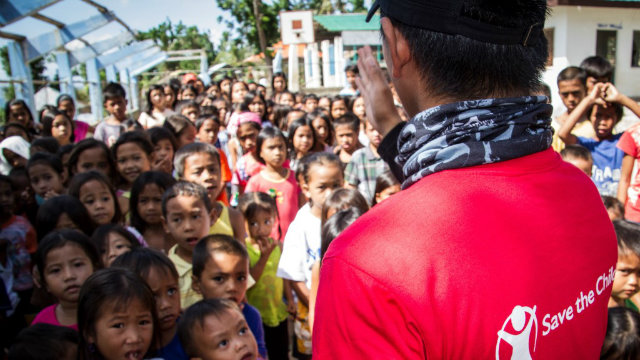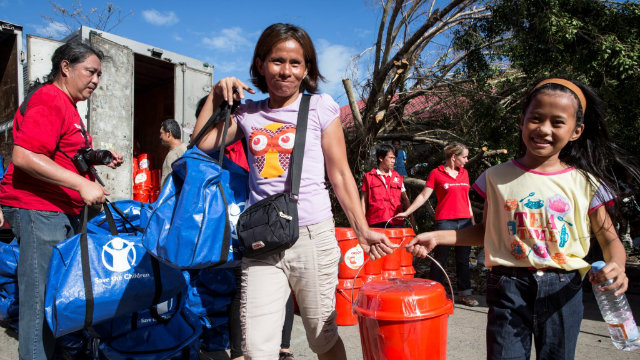SUMMARY
This is AI generated summarization, which may have errors. For context, always refer to the full article.
.jpg) I have worked as a humanitarian in some of the world’s biggest disasters for the past 10 years, across Africa and Asia. I am used to seeing human suffering. Nothing, however, could have prepared me for the devastation caused by Typhoon Yolanda (Haiyan) in November 2013.
I have worked as a humanitarian in some of the world’s biggest disasters for the past 10 years, across Africa and Asia. I am used to seeing human suffering. Nothing, however, could have prepared me for the devastation caused by Typhoon Yolanda (Haiyan) in November 2013.
As the ‘storm tracker’ in Save the Children’s regional office in Singapore, I tracked weather systems in the region, learning to predict the paths they would take and where they would make landfall.
Up to 20 typhoons slam into the Philippines every year. Some cause no damage at all, but others can cause severe localized damage. We could often predict the location and anticipate the level of damage but you never know for certain what’s going to happen until a storm arrives.
As a humanitarian, I always hope for the best but prepare for the worst. As I watched online Yolanda developing over the Philippine Sea, gaining strength and transforming into a typhoon, my concern mounted. When it became clear to me this storm had the potential to cause serious damage, I raised the alarm. Speaking to colleagues around the world, we immediately went to the highest alert. We focused our resources into preparing for a catastrophic disaster.
Save the Children has been working in the Philippines for 30 years. We store emergency equipment in warehouses all over the country so that we can distribute basic necessities instantly in the event of a disaster such as Yolanda.

Calm after the storm
Yolanda hit and…nothing.
People talk about the calm before the storm, but this was a calm after the storm. The eerie silence that terrified us all. We feared for the lives of the residents in the affected communities
The storm had damaged the telecommunication infrastructure, making it very difficult to make contact with anyone in the region. As the initial news reports finally filtered through, a horror dawned on us: the devastation caused by the typhoon was much worse than we could have predicted.
Yolanda is actually the biggest storm to have ever made landfall since we began recording these things. The wind speeds were unprecedented. It killed over 6000 people.
Almost 1000 people are still registered as missing.
My greatest concern for those bearing the brunt of the typhoon was the storm surge. This happens when powerful sea storms sweep vast amounts of water on shore when they make landfall.
Even though people had gone inside to shelter from flying debris when the violent typhoon arrived, many were underprepared for the 5 meter wave of seawater that barreled through the region. People were swept to their deaths. Many drowned.
After a terrifying ordeal for those on the ground, the winds finally dropped. The storm passed.
Traumatic stories of dead bodies in the street started to emerge, whole towns flattened by a storm so ferocious the surge pushed a ship right into the middle of Tacloban.
Houses were totally blown away, trees uprooted, cars picked up and tossed like toys. It is difficult to imagine what a wind speed of over 275 kph feels like.
Nobody outside would have been safe. I have heard stories of people whose skin was literally sandblasted off because of the power of the wind on the coast.

Survivors
Now it was time to focus on the survivors.
I was part of the first international deployment to Manila in the immediate aftermath of Yolanda. My job was to create instant distribution networks to get food, water, medicine, and medical help to the survivors. In the face of such unimaginable chaos, our teams mobilized and headed to the Visayas, the middle of the country, where the storm had passed.
The transport networks were down, so team members hitched rides on planes going into Tacloban, the epicenter of the destruction. Here they were greeted with scenes of absolute carnage: bodies lying in the middle of the street, debris everywhere, dazed people wandering around in shock at having lost family members, their houses and all of their possessions.
In a tragic turn of events, some areas of the affected region had been evacuated, whereas other areas – for varying reasons – had not. Many lives could have been saved if families had decided to move to higher ground, thus avoiding the destructive storm surge.
The sheer scale of devastation was overwhelming, but my colleagues and I are experienced humanitarian aid workers. We know how to distribute basic necessities quickly. We were proud to be one the first organizations to get essential supplies to survivors. In total, we deployed 100 international aid experts, mobilized national staff, and flew in 12 planes of relief stocks.
Our teams immediately assessed the needs and responded accordingly. We gave food to hungry families, provided temporary shelter to those made homeless, and provided child friendly spaces so parents would know their children were safe and being looked after while they tried to put their lives back in order.
One story stands out to me most of all because it gave us a sense of hope in the face of such tragedy. Our team was driving down a road near Tacloban, and past a woman in labor. Our staff pulled over and helped the woman deliver her baby. Seeing them both survive against such difficult odds was a moment of triumph. Small moments like this keep us going with our lifesaving work.
Now, a year on, Save the Children is still helping survivors in the affected areas reestablish their lives. We have reached almost 800,000 people. Some have received life-saving food supplies and medical treatment. Others have received cash to build their houses and restart their livelihoods.
Every day we hear stories of hope and it gives us great encouragement. However, we know the road to recovery is long and difficult for those who lost everything. That is why we’re committed to working alongside the communities affected by Yolanda for at least the next two years. — Rappler.com
Michel Rooijackers is currently the Deputy Country Director of Save the Children in Philippines. Apart from ‘Yolanda’, Rooijackers has responded to a number of disasters in Asia and Africa including Cyclone Nargis in Myanmar, Cambodia floods and ‘Bohol’ Earthquake.
To learn more about Save the Children’s work in the Philippines, visit their website here.
For Rappler’s full coverage of the 1st anniversary of Super Typhoon Yolanda (Haiyan), go to this page.
Add a comment
How does this make you feel?





There are no comments yet. Add your comment to start the conversation.